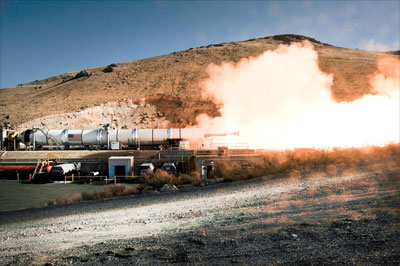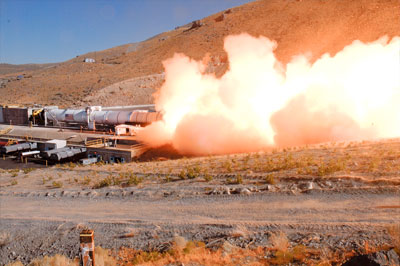 Space News space history and artifacts articles Messages space history discussion forums Sightings worldwide astronaut appearances Resources selected space history documents |
If you have previously registered, but forgotten your password, click here.
Initial test data indicated that the motor, which was chilled to a 40° F core temperature since early July, performed as designed, producing approximately 3.6 million pounds of thrust, or 22 million horsepower, and burned for just over two minutes. The test collected 764 channels of data to accomplish 53 test objectives. This is the most data ATK has ever collected in a static fire test. "The information collected from this test, used together with data from DM-1 and the Ares I-X flight test, will help further validate the five-segment design leading to critical design review next year," said Charlie Precourt, vice president and general manger, ATK Aerospace Systems, Space Launch Systems. "The data will also confirm the performance and reliability of this solid rocket, which can be configured for use on multiple launch vehicles." The five-segment rocket was designed to maximize astronaut safety while providing the United States with an affordable and reliable launch capability for both crew and cargo missions. For example, a single five-segment solid rocket motor first stage, coupled with a liquid upper stage, would be able to lift more than 55,000 pounds of payload directly to Low Earth Orbit. The main test objectives from today's static motor firing were measuring the first-stage rocket's performance at cold temperatures, and verifying the performance of new materials in the motor joints at the lowest range of operational temperatures. "Testing at these extremes aids us in fully understanding all operating conditions for this motor," said Precourt, a former shuttle astronaut. "This data, along with information we have collected over the past three decades, confirms that this is the most powerful and reliable solid rocket motor ever designed, and it is the right motor to ensure the safety of our astronauts." DM-2 is the largest human-rated solid rocket motor built today, measuring 12 feet in diameter and 154 feet in length. The five-segment motor is based on the design heritage of the flight-proven Solid Rocket Boosters on the Space Shuttle Program, and has been upgraded to incorporate modern technologies and materials. These include the addition of a fifth segment, changes to the propellant grain, a larger nozzle opening and upgraded insulation and liner. The five-segment cases remain the same as those used for more than three decades on the Space Shuttle Program. Just like shuttle cases, the cases for this rocket are designed to be recovered and reused. This enables NASA and ATK to collect vital post-flight information and performance data, confirming a safe and robust design. The cases used in this ground test have collectively flown on 59 previous shuttle missions. As the prime contractor, ATK continues to perform on schedule and on cost in support of NASA's space exploration programs. The next test for the program, Development Motor-3, will be a hot temperature test conducted next year. | ||||||||
| Robert Pearlman | NASA release NASA and ATK Successfully Test Five-Segment Solid Rocket Motor | |||||||


